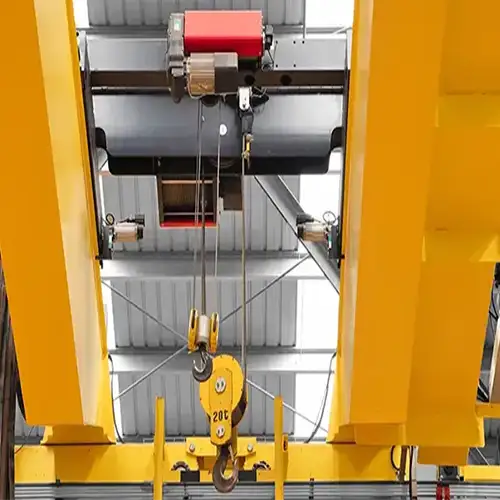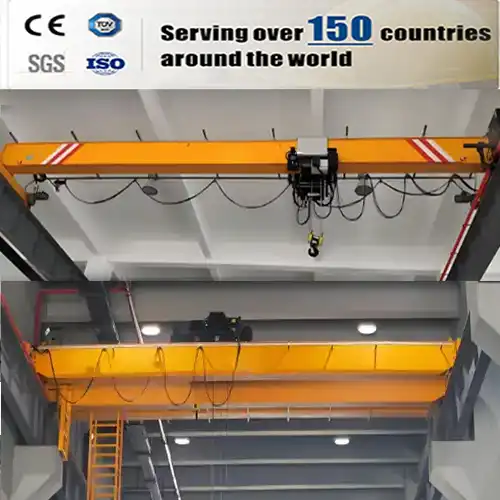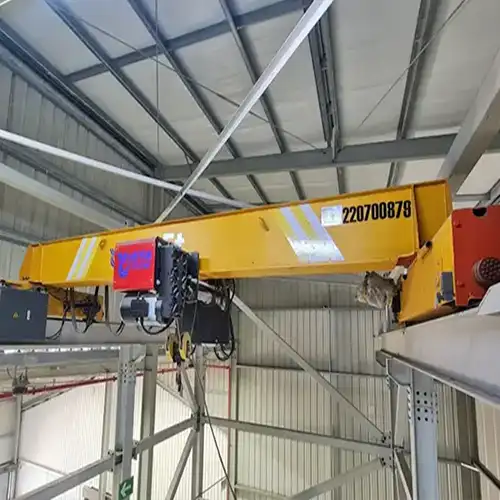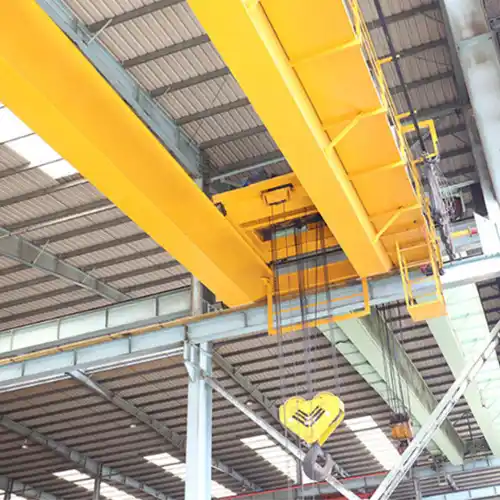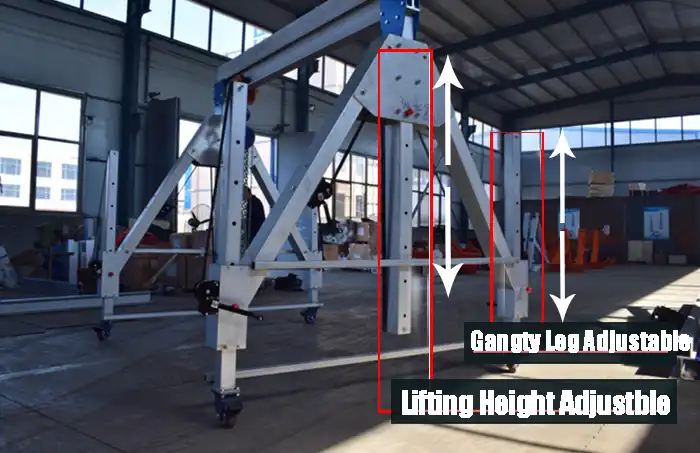
How to Extend the Lifespan of 5 Ton Aluminum Gantry Cranes
How to Extend the Lifespan of 5 Ton Aluminum Gantry Cranes
Aluminum gantry crane maintenance practices:How to extend the lifespan of 5 ton aluminum gantry cranes. Get your selected types of aluminum gantry cranes now. In today's industrial field, 5 ton aluminum gantry cranes play a pivotal role in various applications, from manufacturing and warehousing to construction and logistics. These versatile lifting solutions are known for their efficiency, reliability, and ability to handle heavy loads with precision. However, like any mechanical equipment, gantry cranes require regular maintenance to ensure optimal performance and longevity.
Maintenance is crucial in extending the lifespan of 5 ton aluminum gantry cranes. By implementing a proactive maintenance strategy, businesses can minimize downtime, reduce repair costs, and maximize the return on investment for their crane assets. In this blog, we will explore the importance of maintenance and delve into best practices for keeping 5 ton aluminum gantry cranes in top condition for years to come.
Aluminum Gantry Crane Components
Key Components of 5 Ton Aluminum Gantry Cranes
To effectively maintain a 5 ton aluminum gantry crane, it's essential to understand its key components. These include:
- Aluminum Frame: The main structure of the gantry crane, typically constructed from lightweight yet durable aluminum alloy, providing strength and stability while minimizing weight.
- Legs: The vertical support structures of the gantry crane, supporting the horizontal beam or bridge.
- Bridge: The horizontal beam that spans the distance between the legs, supporting the hoist and trolley assembly.
- Hoist: The lifting mechanism that raises and lowers the load, typically equipped with wire rope or chain for lifting.
- Trolley: The mechanism that moves along the bridge, allowing the hoist to position the load horizontally.
- Controls: The system for operating the gantry crane, including pendant controls, wireless remote controls, or cabin-mounted controls.
aluminum gantry crane for sale 500kg, 1 ton, 2 ton, 3 ton, 5 ton
Common Causes of Wear and Tear
Several factors contribute to wear and tear on gantry crane components, significantly impacting their lifespan and performance. It's essential to be aware of these factors to implement effective maintenance strategies and prolong the crane's operational life:
- Heavy Usage: Gantry cranes subjected to frequent or heavy lifting tasks are more susceptible to wear and tear on critical components like the hoist, trolley, and controls. Continuous usage without proper maintenance can accelerate component degradation and compromise crane performance over time.
- Environmental Factors: Exposure to harsh weather conditions, dust, moisture, and corrosive substances can significantly impact the structural integrity of gantry cranes, especially those with aluminum frames. Corrosion and rust formation on metal components can weaken the crane's structure, leading to safety hazards and reduced functionality.
- Improper Maintenance: Neglecting regular maintenance practices such as lubrication, inspection, and part replacement can exacerbate wear and tear on gantry crane components. Inadequate lubrication can cause friction and premature wear on moving parts, while ignoring early signs of damage can lead to more significant issues down the line.
- Overloading: Operating the gantry crane beyond its rated capacity puts excessive strain on its components, leading to accelerated wear and potential breakdowns. Overloading not only compromises safety but also reduces the crane's longevity and increases the risk of catastrophic failures.
- Aging Components: As gantry cranes age, their components naturally degrade due to factors like material fatigue, metal fatigue, and wear. It's crucial to conduct regular inspections and maintenance to identify aging components and address them promptly to prevent unexpected failures.
Understanding these factors is crucial for implementing proactive maintenance measures to mitigate wear and tear on gantry crane components. By addressing these issues early and adopting a preventive maintenance approach, businesses can extend the lifespan of their gantry cranes, optimize their performance, and ensure safe and efficient lifting operations.
Maintenance Schedule and Routine Inspections
Establishing a Regular Maintenance Schedule
Maintaining a regular maintenance schedule is crucial for preserving the optimal performance and longevity of 5-ton aluminum gantry cranes. Here's how to establish an effective maintenance schedule:
- Frequency: Determine the frequency of maintenance tasks based on factors such as how often the crane is used, the operating environment, and manufacturer recommendations. For heavily used cranes or those operating in harsh conditions, more frequent maintenance may be necessary to prevent premature wear and ensure reliability.
- Tasks: Define the specific maintenance tasks to be performed during each scheduled interval. This may include lubricating moving parts, inspecting critical components for signs of wear or damage, and replacing worn-out parts. Creating a comprehensive checklist of maintenance tasks ensures that no essential aspect is overlooked during inspections.
- Documentation: Keep detailed records of all maintenance activities to track the crane's maintenance history effectively. Document the dates of each maintenance session, the tasks performed, any issues identified, and the actions taken to address them. Maintaining accurate records enables maintenance personnel to track the crane's performance over time and identify any recurring issues that may require further attention.
- Compliance: Ensure compliance with relevant regulatory requirements and industry standards governing gantry crane maintenance. Safety is paramount in crane operations, so it's essential to adhere to established guidelines for inspecting and maintaining safety-critical components such as brakes, hoists, and electrical systems. Regular inspections and adherence to safety protocols minimize the risk of accidents and ensure compliance with legal obligations.
By establishing a well-defined maintenance schedule and adhering to it consistently, businesses can optimize the performance and longevity of their 5-ton aluminum gantry cranes while ensuring the safety of personnel and equipment. Regular maintenance not only reduces the risk of unexpected downtime and costly repairs but also enhances overall operational efficiency and productivity.
Conducting Routine Inspections for Early Detection of Issues
Routine inspections are crucial for identifying potential issues before they escalate into major problems.Implementing a comprehensive inspection program is essential for maintaining the safety and performance of 5-ton aluminum gantry cranes. Here are five key elements to include in an effective inspection routine:
- Visual Inspection: Regularly visually inspect all components of the gantry crane, including the frame, legs, bridge, hoist, trolley, controls, and electrical wiring. Look for signs of wear, damage, or corrosion that may indicate potential issues or safety hazards. Visual inspections help identify problems early, allowing for timely intervention and preventive maintenance.
- Functional Checks: Perform functional checks of critical components such as the hoist, trolley, and controls to ensure they operate smoothly and without unusual noises or vibrations. Test each component according to manufacturer specifications to verify proper functionality and responsiveness. Functional checks help detect mechanical issues that may affect the crane's performance and safety during operation.
- Load Testing: Periodically conduct load testing to verify the crane's lifting capacity and stability under real-world conditions. Use calibrated weights or simulated loads to apply incremental stress to the crane and evaluate its performance. Load testing helps ensure that the crane can safely handle the intended loads without exceeding its rated capacity or compromising structural integrity.
- Documentation: Document the findings of routine inspections, including any issues identified, corrective actions taken, and recommendations for future maintenance or repairs. Maintain detailed records of inspection dates, findings, and maintenance activities to track the crane's condition over time. Documentation serves as a valuable reference for monitoring trends, identifying recurring issues, and planning maintenance schedules effectively.
- Training: Ensure that personnel responsible for conducting routine inspections are properly trained and equipped with the necessary tools and resources to perform thorough and effective inspections. Provide training on inspection procedures, safety protocols, and equipment operation to enhance inspection accuracy and consistency. Regular training sessions help reinforce best practices and ensure that inspection personnel stay up-to-date with industry standards and regulations.
By incorporating these key elements into a structured inspection program, businesses can proactively identify and address potential issues, minimize downtime, and maintain the safety and reliability of their 5-ton aluminum gantry cranes. Regular inspections help extend the lifespan of the crane and maximize its performance, contributing to overall operational efficiency and productivity.
By establishing a regular maintenance schedule and conducting routine inspections, businesses can proactively identify and address issues, minimize downtime, and extend the lifespan of their 5 ton aluminum gantry cranes.
Lubrication and Cleaning Procedures
Importance of Proper Lubrication for Moving Parts
Proper lubrication is essential for maintaining the smooth operation and longevity of moving parts in 5 ton aluminum gantry cranes. Here's why lubrication is crucial:
- Friction Reduction: Lubricants reduce friction between moving parts, minimizing wear and tear and extending the lifespan of components such as bearings, gears, and chains.
- Preventing Corrosion: Lubricants create a protective barrier that shields metal surfaces from moisture and corrosion, particularly in harsh or outdoor environments.
- Temperature Control: Lubricants help dissipate heat generated by friction, preventing overheating and prolonging the lifespan of critical components.
- Noise Reduction: Properly lubricated components operate more quietly, reducing noise levels in the workplace and improving operator comfort.
Cleaning Procedures to Prevent Corrosion and Dirt Buildup
Regular cleaning is essential for preventing corrosion and dirt buildup on gantry crane components. Here are key cleaning procedures to follow:
- Remove Debris: Use compressed air or a brush to remove dirt, dust, and debris from exposed surfaces, joints, and moving parts of the crane.
- Wash with Mild Detergent: Use a mild detergent and water solution to clean the crane's frame, legs, bridge, and other components, paying special attention to areas prone to corrosion.
- Rinse Thoroughly: Rinse the crane thoroughly with clean water to remove any remaining detergent residue and prevent streaking or discoloration.
- Dry Completely: Ensure that all components are completely dry before lubricating to prevent moisture-related issues such as rust and corrosion.
- Apply Lubricant: Once the crane is clean and dry, apply the appropriate lubricant to moving parts such as bearings, gears, wheels, and chains according to manufacturer recommendations.
By following proper lubrication and cleaning procedures, businesses can protect their 5 ton aluminum gantry cranes from premature wear and corrosion, ensuring reliable performance and extending their lifespan.
Repair and Replacement Guidelines
Identifying Signs of Wear and Damage
Regular inspection is crucial for identifying signs of wear and damage in 5 ton aluminum gantry cranes. Here are common indicators to watch for:
- Excessive Noise: Unusual noises such as grinding, squeaking, or rattling during crane operation may indicate worn or damaged components.
- Visual Inspection: Inspect the crane's components, including the frame, legs, bridge, wheels, bearings, and electrical connections, for signs of corrosion, cracks, dents, or deformities.
- Misalignment: Check for misalignment of structural elements, such as bent or skewed legs, which can affect the crane's stability and performance.
- Reduced Performance: Pay attention to any decrease in the crane's lifting capacity, speed, or responsiveness, as this may indicate mechanical issues or component wear.
- Leaks or Fluid Loss: Look for leaks or fluid loss in hydraulic systems, pneumatic systems, or lubrication points, which can indicate seal failures or other issues.
Guidelines for Repairing or Replacing Components
Once signs of wear or damage are identified, it's essential to follow proper guidelines for repairing or replacing components:
- Assess the Severity: Evaluate the severity of the wear or damage and determine whether repair or replacement is necessary. Minor wear may be addressed through maintenance tasks such as lubrication or adjustment, while significant damage may require component replacement.
- Consult Manufacturer Guidelines: Refer to the manufacturer's maintenance manual or guidelines for specific instructions on repairing or replacing components. Follow recommended procedures and specifications to ensure safety and compliance.
- Use Genuine Parts: When replacing components, use genuine manufacturer parts to maintain the integrity and performance of the crane. Substituting with aftermarket or incompatible parts can compromise safety and reliability.
- Professional Assistance: For complex repairs or replacements, enlist the help of qualified technicians or service personnel with experience in gantry crane maintenance. They can provide expert diagnosis and ensure proper execution of repair tasks.
- Preventive Maintenance: Implement a preventive maintenance program to address minor issues before they escalate into major problems. Regular inspection, lubrication, and cleaning can help prolong the lifespan of gantry crane components and minimize the need for repairs.
By promptly identifying signs of wear and damage and following proper repair and replacement guidelines, businesses can ensure the continued reliability, safety, and performance of their 5 ton aluminum gantry cranes.
Safety Considerations During Maintenance
Implementing Safety Protocols for Maintenance Tasks
During maintenance activities on 5 ton aluminum gantry cranes, it's essential to prioritize safety to prevent accidents and injuries. Here are some safety protocols to implement:
- Training: Ensure that maintenance personnel are adequately trained in safe work practices, including proper handling of tools and equipment, use of personal protective equipment (PPE), and adherence to safety procedures.
- Lockout/Tagout Procedures: Implement lockout/tagout (LOTO) procedures to de-energize and lock out power sources before performing maintenance tasks. This prevents accidental startup of the crane and protects workers from electrical hazards.
- Fall Protection: Use fall protection equipment, such as harnesses and lanyards, when working at heights or on elevated platforms. Install guardrails or safety nets to prevent falls from gantry crane structures.
- Equipment Inspection: Inspect tools and equipment before use to ensure they are in good condition and free from defects. Replace worn or damaged tools and equipment to prevent accidents during maintenance tasks.
- Hazard Identification: Identify potential hazards associated with maintenance activities, such as moving parts, electrical systems, and hydraulic components. Implement control measures to mitigate these hazards and protect workers from harm.
Ensuring Compliance with Safety Regulations
Compliance with safety regulations is essential to maintain a safe working environment and prevent accidents. Here are steps to ensure compliance:
- Regulatory Review: Familiarize yourself with relevant safety regulations, standards, and guidelines applicable to gantry crane maintenance, such as those set forth by OSHA (Occupational Safety and Health Administration) or ANSI (American National Standards Institute).
- Documentation: Maintain accurate records of maintenance activities, safety inspections, training sessions, and equipment certifications to demonstrate compliance with regulatory requirements.
- Periodic Audits: Conduct periodic safety audits and inspections to assess compliance with safety regulations and identify areas for improvement. Address any non-compliance issues promptly to avoid penalties or fines.
- Continuous Training: Provide ongoing training and education to maintenance personnel to ensure awareness of safety regulations, procedures, and best practices. Encourage participation in safety meetings and discussions to promote a safety culture within the organization.
- Collaboration with Authorities: Collaborate with regulatory authorities, safety professionals, and industry associations to stay updated on changes in safety regulations and best practices. Seek guidance and assistance as needed to address compliance issues and improve safety standards.
By implementing robust safety protocols and ensuring compliance with safety regulations, businesses can protect the well-being of maintenance personnel and maintain a safe working environment during gantry crane maintenance activities.
Training and Skill Development
Providing Training for Maintenance Personnel
Effective training is crucial for ensuring that maintenance personnel have the necessary skills and knowledge to perform their duties safely and effectively. Here are some key aspects of providing training for maintenance personnel:
- Comprehensive Training Programs: Develop comprehensive training programs that cover all aspects of gantry crane maintenance, including inspection, lubrication, cleaning, repair, and safety procedures. Tailor training sessions to the specific needs and skill levels of maintenance personnel.
- Hands-On Training: Incorporate hands-on training exercises to allow maintenance personnel to gain practical experience in performing maintenance tasks on gantry cranes. Provide opportunities for trainees to work under the guidance of experienced mentors to reinforce learning and build confidence.
- Safety Training: Prioritize safety training to ensure that maintenance personnel understand and adhere to safety protocols when working on gantry cranes. Cover topics such as hazard identification, fall protection, lockout/tagout procedures, and emergency response.
- Equipment-Specific Training: Provide training on the specific make and model of gantry cranes used in the facility, including familiarization with control systems, operating manuals, and maintenance schedules. Ensure that maintenance personnel are proficient in troubleshooting common issues and performing routine maintenance tasks.
- Continuing Education: Encourage ongoing learning and skill development through continuing education programs, workshops, and certifications. Stay updated on advancements in gantry crane technology, maintenance practices, and safety regulations to continuously improve skills and knowledge.
Developing Skills for Effective Crane Maintenance
Developing skills for effective gantry crane maintenance requires a combination of technical expertise, problem-solving abilities, and attention to detail. Here are some strategies for developing skills in crane maintenance:
- Technical Proficiency: Ensure that maintenance personnel have a strong foundation in mechanical, electrical, and hydraulic systems relevant to gantry cranes. Provide training on troubleshooting techniques and diagnostic procedures to identify and resolve issues efficiently.
- Problem-Solving Skills: Foster problem-solving skills among maintenance personnel to address complex maintenance challenges and unexpected issues that may arise during crane operations. Encourage critical thinking and creativity in developing solutions to optimize crane performance and reliability.
- Attention to Detail: Emphasize the importance of attention to detail in crane maintenance tasks, such as conducting thorough inspections, following maintenance procedures accurately, and documenting findings accurately. Stress the significance of precision and thoroughness in maintaining crane safety and reliability.
- Communication and Collaboration: Promote effective communication and collaboration among maintenance personnel, operators, and other stakeholders involved in crane operations. Encourage teamwork and information sharing to facilitate timely maintenance interventions and ensure smooth coordination between departments.
- Continuous Improvement: Foster a culture of continuous improvement by encouraging feedback, soliciting ideas for process enhancements, and implementing best practices in crane maintenance. Provide opportunities for skill enhancement and career development to motivate maintenance personnel and promote professional growth.
By providing comprehensive training programs and fostering skill development in crane maintenance, businesses can ensure that maintenance personnel are equipped with the knowledge, expertise, and capabilities needed to effectively maintain gantry cranes and support safe and efficient operations.
Case Studies: Successful Maintenance Strategies
Real-Life Examples of Maintenance Success Stories
Real-life case studies offer valuable insights into successful maintenance strategies implemented by businesses to prolong the lifespan of their 5 ton aluminum gantry cranes. Here are some examples of maintenance success stories:
Case Study 1: Automotive Manufacturing Plant
In this case study, an automotive manufacturing plant implemented a proactive maintenance approach for their gantry cranes. Regular lubrication, routine inspections, and timely repairs were key components of their maintenance strategy.
As a result, the plant experienced minimal downtime due to crane-related issues, leading to improved productivity and cost savings. The proactive approach to maintenance helped identify potential problems early and address them before they escalated into major issues.
Case Study 2: Warehouse and Distribution Center
In this case study, a warehouse and distribution center implemented a comprehensive maintenance program for their gantry cranes, which included regular cleaning, lubrication, and inspection of critical components.
By adhering to a strict maintenance schedule and conducting routine inspections, the center was able to detect and address minor issues before they caused significant downtime. This proactive approach resulted in improved crane reliability and operational efficiency.
Case Study 3: Aerospace Manufacturing Facility
In this case study, an aerospace manufacturing facility employed advanced predictive maintenance techniques for their gantry cranes, utilizing sensors and data analytics to monitor crane performance in real time.
By leveraging predictive maintenance technology, the facility was able to anticipate potential issues and schedule maintenance activities proactively, minimizing unplanned downtime and maximizing crane uptime. This proactive approach contributed to improved safety and operational efficiency.
Lessons Learned and Best Practices from Case Studies
From these case studies, several key lessons and best practices emerge:
- Proactive Maintenance: Implementing a proactive maintenance approach, including regular inspections, lubrication, and cleaning, can help prevent costly breakdowns and extend the lifespan of gantry cranes.
- Utilization of Technology: Leveraging technology such as sensors and data analytics enables businesses to monitor crane performance in real time, identify potential issues early, and schedule maintenance activities proactively.
- Adherence to Maintenance Schedule: Strict adherence to a maintenance schedule ensures that maintenance tasks are performed regularly and consistently, reducing the risk of unexpected downtime and prolonging crane lifespan.
- Training and Education: Providing comprehensive training for maintenance personnel ensures they have the skills and knowledge to perform maintenance tasks effectively and safely. Continuous education and skill development contribute to ongoing improvement in maintenance practices.
By incorporating these lessons and best practices into their maintenance strategies, businesses can optimize the performance, reliability, and longevity of their 5 ton aluminum gantry cranes, ultimately maximizing operational efficiency and minimizing downtime.
Benefits of Effective Maintenance
Extended Lifespan of Gantry Cranes
Effective maintenance practices play a crucial role in extending the lifespan of 5 ton aluminum gantry cranes. Regular inspection, lubrication, and repair of components are key factors in preventing premature wear and tear, corrosion, and other forms of damage that can compromise the crane's performance and durability. By implementing a proactive maintenance schedule, businesses can identify and address potential issues before they escalate, ensuring that the gantry crane remains in optimal condition for an extended period.
Furthermore, proper maintenance helps to preserve the structural integrity of the gantry crane, reducing the risk of component failure and structural damage. By keeping the crane's components well-maintained and functioning smoothly, businesses can minimize the likelihood of unexpected breakdowns and downtime, thereby maximizing productivity and operational efficiency.
In addition to preventing damage, effective maintenance practices also contribute to the overall safety of gantry crane operations. Regular inspections allow maintenance personnel to identify and address safety hazards, such as worn-out components or malfunctioning parts, before they pose a risk to workers or equipment. By maintaining a safe working environment, businesses can protect their employees and assets while avoiding costly accidents and injuries.
Overall, investing in maintenance not only extends the lifespan of 5 ton aluminum gantry cranes but also enhances safety, reliability, and productivity. By prioritizing maintenance as an integral part of their operations, businesses can ensure that their gantry cranes continue to deliver optimal performance and value for years to come.
Cost Savings and Reduced Downtime
Implementing effective maintenance measures for 5 ton aluminum gantry cranes can result in substantial cost savings for businesses. By proactively identifying and addressing potential issues through routine inspections and repairs, businesses can avoid expensive breakdowns and unplanned downtime. This proactive approach minimizes the need for emergency repairs, replacement parts, and the associated costs of lost productivity due to crane downtime.
Furthermore, proper maintenance helps businesses optimize their operational efficiency by ensuring that gantry cranes are operating at peak performance levels. Regular lubrication, cleaning, and adjustment of components help prevent wear and tear, reducing the likelihood of costly repairs or replacements down the line. By addressing minor issues before they escalate into major problems, businesses can mitigate the risk of costly repairs and minimize disruptions to their operations.
In addition to reducing maintenance costs, effective maintenance practices also contribute to reduced downtime, which translates to increased productivity and revenue generation. By keeping gantry cranes well-maintained and operating smoothly, businesses can minimize the frequency and duration of unplanned downtime, allowing them to meet production deadlines and fulfill customer orders on time.
Moreover, extending the lifespan of gantry cranes through proper maintenance helps businesses delay the need for costly replacements. By maximizing the longevity of existing equipment, businesses can defer capital expenditures associated with purchasing new cranes, saving them significant capital expenditure in the long run.
Overall, effective maintenance practices help businesses optimize their operational efficiency, reduce expenses, and enhance their bottom line. By prioritizing maintenance as an integral part of their operations, businesses can realize substantial cost savings while ensuring the reliable performance of their gantry cranes.
Conclusion
In summary, implementing maintenance best practices is essential for extending the lifespan and ensuring the reliable performance of 5 ton aluminum gantry cranes. By following a regular maintenance schedule, conducting routine inspections, lubricating moving parts, and promptly addressing any signs of wear or damage, businesses can keep their gantry cranes in optimal condition. Additionally, providing proper training for maintenance personnel and adhering to safety protocols during maintenance tasks are critical aspects of effective maintenance management.
Prioritizing maintenance is crucial for maximizing the longevity and operational efficiency of gantry cranes. Neglecting maintenance can lead to accelerated wear and tear, equipment failure, and costly downtime. By investing time and resources into proactive maintenance practices, businesses can prevent breakdowns, extend the lifespan of their gantry cranes, and ultimately save money in the long run. Moreover, prioritizing maintenance demonstrates a commitment to safety, productivity, and operational excellence, which are essential for sustaining business success. Therefore, businesses should recognize the importance of maintenance and make it a priority in their operations to ensure the continued reliability and performance of their gantry cranes.
